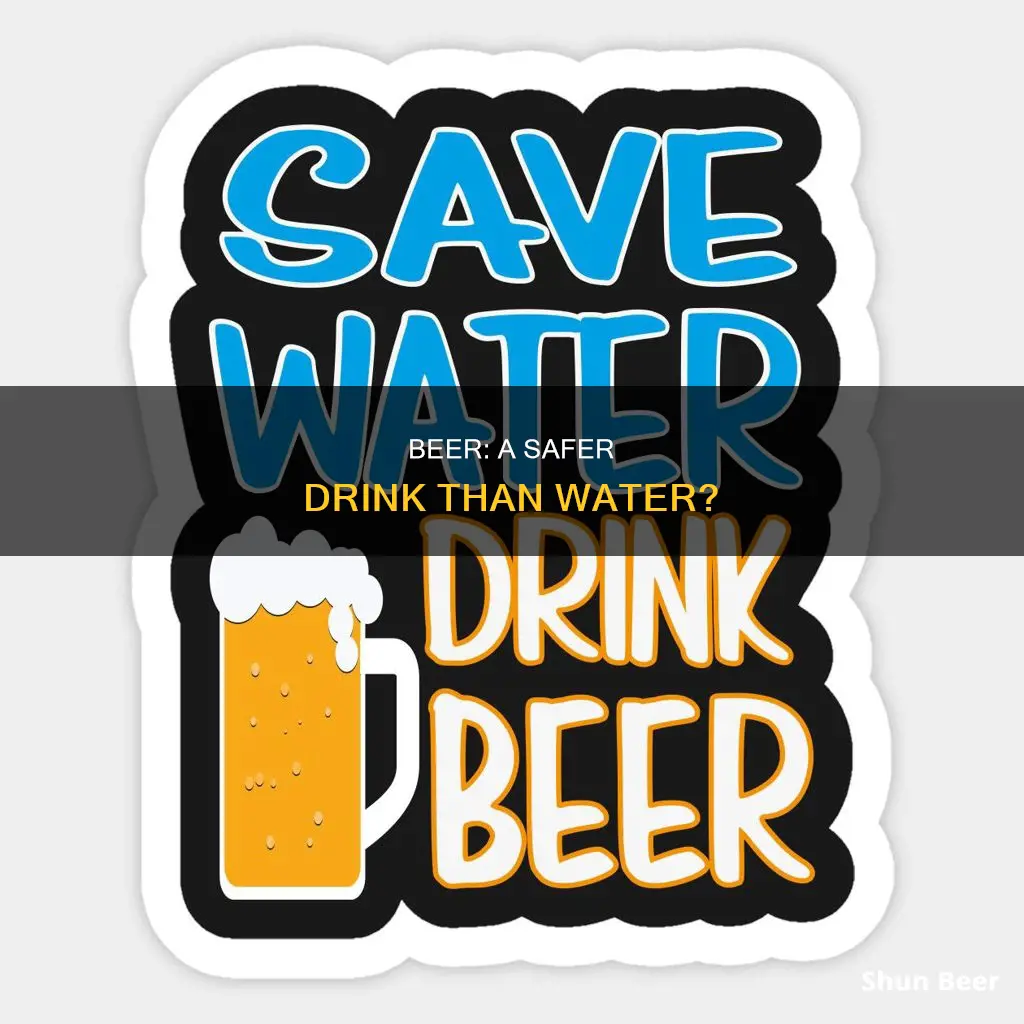
It is a common misconception that people in Medieval Europe drank beer instead of water because the water was unsafe. In fact, water was both free and accessible, as most towns and villages were built around a water source. People could tell the difference between clean and contaminated water, and medieval cities spent large amounts of money on creating and maintaining water supplies. Beer was not a replacement for water but was viewed as a more nutritious alternative, packed with calories to fuel people through their physically demanding jobs.
| Characteristics | Values |
|---|---|
| Was beer safer to drink than water? | No, it was a myth. People drank water and beer. |
| Why did people believe this myth? | Beer was viewed as a more nutritious alternative to water. |
| Was water accessible? | Yes, water was free and readily accessible as most towns and villages were built around a water source. |
| Was water clean? | Yes, water was clean and well-maintained. |
| Did people know about water contamination? | Yes, people could tell the difference between a clean water source and a contaminated one. |
What You'll Learn

Beer was not a replacement for water
It is a common misconception that people in Medieval Europe drank beer instead of water. While beer was indeed consumed, it was not a replacement for water.
Firstly, water was both free and easily accessible. Most towns and villages were built near a water source, such as a river or stream, and communities understood the importance of keeping these sources clean. Medieval Europeans also had the knowledge to differentiate between clean and contaminated water. For instance, they knew that water from marshy areas or stagnant sources was unsafe to drink.
Moreover, there is ample evidence that people regularly drank water. Medieval cities invested significant amounts of money in creating and maintaining water supplies. For example, in the 13th century, London developed a complex pipe system to provide its citizens with clean water. This infrastructure included the construction of the Great Conduit, an underground channel that brought drinking water from springs to the city centre.
Water was also the preferred drink for religious and penance reasons. Many saints are recorded to have abstained from alcohol, opting for water instead. Bread and water were also a common form of atonement for sins in the Medieval period.
Beer, however, served a different purpose. It was primarily consumed for its nutritional benefits, providing both calories and hydration to those performing manual labour. Beer was also cheaper than wine and, if home-brewed, could be more accessible than wine or spirits.
In conclusion, while beer was certainly a popular drink in Medieval Europe, it did not replace water as a primary source of hydration. Water was widely consumed and valued for its role in daily life, health, and religious practices.
Jaundice Recovery: Is Beer a Friend or Foe?
You may want to see also

Water was free and accessible
In larger towns, there was infrastructure in place to ensure the supply of clean water to citizens. London, for example, had developed a complex pipe system by 1237. The City of London acquired the springs of the Tyburn and built a small reservoir to help serve the city with a steady, free, flowing supply.
People in medieval times also had the knowledge to differentiate between clean and contaminated water sources. They would not drink water that looked or smelled bad, and tradesmen who used water faced fines if they polluted the town's drinking supply.
Water was also the preferred drink of the saints, who, according to Medieval religious manuscripts, often chose to drink water instead of alcohol.
Medieval people also had the option of mixing water with wine or honey to improve the flavour.
Beer Hour: Understanding the Social Drinking Culture
You may want to see also

Beer was a nutritional supplement
While it is a popular myth that beer was considered a safer alternative to water, beer was more of a nutritional supplement than a method of hydration. Beer was a source of carbohydrates, protein, B vitamins, and minerals such as folate, niacin, magnesium, and potassium. However, it is important to note that the amounts of these nutrients in beer are relatively small, and whole foods like fruits and vegetables are better sources.
Beer was also believed to have some health benefits when consumed in moderation. Studies suggest that light to moderate beer intake may be associated with a lower risk of heart disease, improved blood sugar control, stronger bones, and reduced dementia risk. Additionally, moderate consumption of any alcoholic beverage, including beer, is associated with lower rates of cardiovascular disease. However, excessive drinking can lead to various health issues, including depression, weight gain, liver disease, and an increased risk of certain cancers.
In medieval times, small beer was a popular drink, providing both calories and fluids to those performing manual labour. It was also cheap and readily available, often made from the third runnings of the mash from brewing ales. While it is unlikely that people drank small beer specifically for its low alcohol content or for killing bugs in polluted water, as they lacked the knowledge of microbes, it served as an energy-providing alternative to water.
Is Budweiser Beer Gluten-Free? Safe for Celiacs?
You may want to see also

Water sources were not avoided
In the Middle Ages, water was both free and readily accessible, as most towns and villages were built around a water source. Medieval people were also able to tell the difference between a clean water source and one that might have been contaminated. They understood that water could be good or bad, but this was limited to its smell and flavour. People who could afford it would pay for good, clean water. In London, a complex pipe system was developed by 1237 to supply the city with water. There were also masters of the conduits who looked after the pipes and ensured those who used the water paid for what they took. By 1600, there were around 4,000 water carriers in London.
Medieval people did not drink water that looked or smelled bad, and tradesmen who used water faced hefty fines if they polluted the town's drinking supply. Regulations were also put in place to prevent the dumping of rubbish or waste into water sources. For example, by 1347, it was forbidden to dump rubbish or dung into the Thames River in London.
The idea that medieval people avoided water sources because they were unsafe to drink is a myth. While beer was commonly consumed in medieval times, it was not a replacement for water. Beer was viewed as a more nutritious alternative to water, providing calories and energy to those performing manual labour. It was also used to pay taxes and tithes. However, beer was more expensive than water, as it had to be purchased, and there were often taxes and transportation fees involved.
Craft Beer Connoisseurship: Is Price Worth the Taste?
You may want to see also

Beer was a source of energy
Beer has been an important source of energy and nutrition for centuries. The drink contains crucial nutritional compounds such as carbohydrates, proteins, and alcohol, which contribute to its total energy value.
In medieval Europe, beer was a popular source of energy, especially for peasants performing hard labor. The beer available at the time was weaker than today's beer, with an alcohol by volume (ABV) of around three percent. As such, people did not drink it to get drunk but rather as a source of calories and hydration.
Beer was also a cheap source of energy, often made from the third runnings of the mash from brewing ales. It was likely quite low in alcohol content, though the exact amount is unknown. Medieval ale brewing was far less efficient than today, and the crops used were less efficient at converting into fermentable sugars.
Today, beer still provides energy in the form of ethanol, which is produced by fermenting the sugars in starch or sugar-based crops such as grains, fruits, and vegetables. Ethanol is a poor source of energy compared to our three major nutrients for energy (carbohydrates, proteins, and fats), and it is lacking in nutrients. However, it provides seven calories per gram, almost twice the amount of energy we get from one gram of carbohydrate.
Heavy drinkers may experience an extra boost of brain energy from alcohol, according to a Yale University study. The study found that heavy drinking may accelerate the body's ability to turn alcohol into energy-boosting acetate, especially in the brain.
In summary, beer has been a significant source of energy throughout history, providing crucial calories and hydration to medieval peasants and continuing to provide energy in the form of ethanol today.
Beer Drinking in the Middle Ages: A Medieval Times Guide
You may want to see also
Frequently asked questions
It is a popular myth that beer was considered safer to drink than water in medieval times. In reality, water was both free and readily accessible, as most towns and villages were built around a water source. People were able to tell the difference between a clean water source and one that might have been contaminated.
Beer was indeed popular in medieval times, but not more so than water. Beer was viewed as a more nutritious alternative to water, providing calories and energy. However, it would have been more costly to drink than water, as it had to be purchased, and there were often taxes and transportation fees involved.
Yes, water was considered a basic need for human survival, and very few civilisations have not been established near a source of clean water. Medieval cities often had infrastructure in place to supply water to citizens, and there are records of local leaders making efforts to give people access to water.
Beer became popular mainly because it was full of calories. Most people in medieval times had jobs that involved manual labour, such as farming or blacksmithing. These jobs required a lot of energy, which beer could provide. Beer was also seen as having good nutritional value, as the boiling of the mash during the brewing process killed any harmful bacteria in the water.







